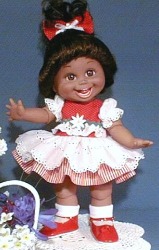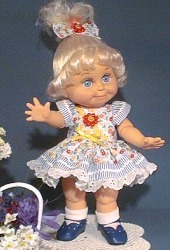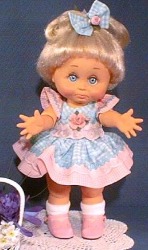
PrillyCharmin's
Sewing Tips
10 Quick Tips to Improve your
Sewing
Copyright 2009 Cynthia Stevens
   
1. IRON AS YOU GO...
Don't be lazy about ironing! If you iron your
pieces as you go, your garments will improve
100%. Be sure to use a STEAM iron. You don't need
to buy the biggest and the best. Any cheap steam
iron will last for years. And use distilled water
in your iron at all times, or else your iron will
spit out chunks of lime when you least expect it.
2. TRACE IT...
Trace your dolly patterns onto the fabric. Don't
try to cut around the teeny pieces. If you trace
around the pieces using dressmaker chalk or light
pencil, then your pieces will be much more
precise and the fit will be more precise as well.
When I cut the fabric out, I cut inside the
tracing lines so I won't get pencil or chalk on
my dolls.
3. PRACTICE FIRST... If
you are using a new pattern, make a practice
outfit first. Iron the practice garment, and put
it on the doll. Analyze how it fits. Is it too
short, too long? is the sleeve too big or bulky?
Is the bodice too wide? Make note of all
necessary adjustments and write it down. Tuck
your notes in with the pattern so you can
remember next time you use it. Once you get the
hang of working with your favorite patterns and
your favorite dolls, your dolly garments will
stand out in the crowd because the FIT is
perfect.
4. GATHERS... Be
sure to gather the sleeves and gather the skirt,
BEFORE you stitch them to the bodice. Do you know
how to gather? Set the sewing machine to a long
straight stitch. Sew along the edge of the piece
that needs to be gathered. Grab one thread from
this line of stitching, and pull on the thread to
pucker up the fabric. Continue to gather the
fabric until it's the right length. If you're
sewing a skirt to a bodice, arrange the gathers
evenly around the skirt. If you're gathering a
puff sleeve, then arrange most of the gathers at
the top of the sleeve but don't bunch it all up
at the top either. ---- If you want to do an even
better job of making gathers, you can stitch TWO
rows side by side and gather BOTH rows of
stitching at the same time. This makes even
better gathers that are very evenly spaced. Try
it and you'll see the difference.
5. VELCRO... Never
use stick-on velcro because the adhesive
doesn't work on fabric. It makes a sticky mess,
sooner or later. Never use glue or a hotglue gun
to attach velcro or doodads. Whenever possible,
you should stitch all buttons, ribbons, rosettes
and velcro to the gown (by hand or with the
machine.) Hot glue is for crafters, not
seamstresses. It doesn't take much more effort to
sew on velcro than it does to glue it. BTW, soft
velcro is more desirable for dolly garments. You
can also buy narrow velcro for dolls. These
specialty velcros are available at online shops.
6. THREAD... If
you're having a terrible time with your thread,
then change to a different spool of thread and
change your sewing machine needle, too. I don't
buy cheap thread anymore, it's not worth it. I
threw away a generic brand spool recently because
it snarled constantly. When I changed to a
different spool of Coats and Clarks white, I had
no more problems. The needle can also cause these
frustrations.
7. TENSION... If
you're not sure how to adjust the tension on your
machine, ask someone to show you. It would be
worth it to take the machine to a sewing repair
shop just for this lesson. And it probably
wouldn't hurt to have the machine serviced while
it was there. You absolutely must have some
confidence in your sewing machine. And you must
be able to make these little adjustments for
yourself.
8. SCISSORS...
Buy some good scissors in several sizes (small
medium and large), including a good pair of
mediums size dressmaker shears, which are the
kind that lay flat on the table when you are
cutting. Your scissors should not be too big and
bulky for the fabric you are cutting. On the
other hand, if you are cutting heavy fabric such
as denim then you need big scissors. This is an
investment: buy several sizes of good sharp
scissors, including some small trimmers to keep
handy while you are working at the machine. Your
scissors don't need to be expensive to be good.
In fact, I appreciate my Fiskars-clone scissors
more than my name brand Singer shears. Sewing
scissors should never be used around the house
for cutting paper or household projects. Paper
will dull your scissors. HIDE your sewing
scissors from the rest of the family! Let them
know your sewing scissors are off-limits.
9. COMFORT &
CONVENIENCE... Portable machines are
awkward to work on. Buy a used cabinet or
portable sewing table if you can. Set up a
permanent sewing space so it's CONVENIENT for you
to do a little sewing and mending whenever you
need to. I have never packed away my sewing
machine ever. A sewing machine can always fit
into some corner somewhere: they're not that big.
Then it's always ready to use, immediately, when
I need it. Otherwise you'll never be able to get
serious about sewing because it's too much work
to set up and tear down again.
10. NEEDLES... Don't
use the same sewing machine needle for
everything. Needles come in various sizes. A 60
needle is for the most delicate fabrics. A 70
needle also handles lightweight fabrics. An 80
needle is considered an all-purpose average size.
A 90 needle is for heavier fabrics and denims.
(However, in order to sew effectively on denim or
canvas it's best to have a machine with a
heavy-duty-power setting. Together with a good
needle in the correct gauge, you can sew through
anything that will fit under the presser foot.)
And finally, don't try to "save"
needles that seem to be damaged. If the point has
been chipped off or it's slightly bent, then
change the needle. There are times when it's good
to be frugal, but not with sewing machine
needles.
|